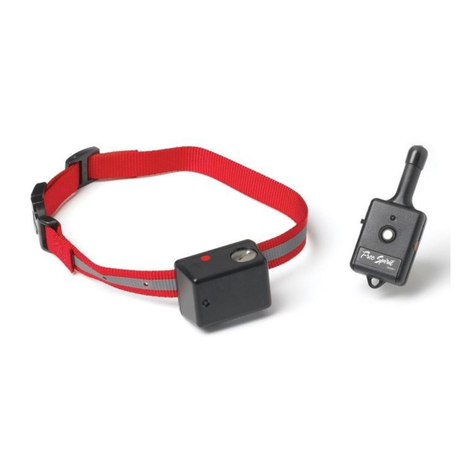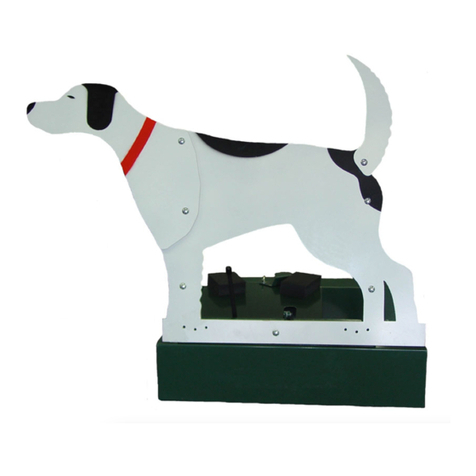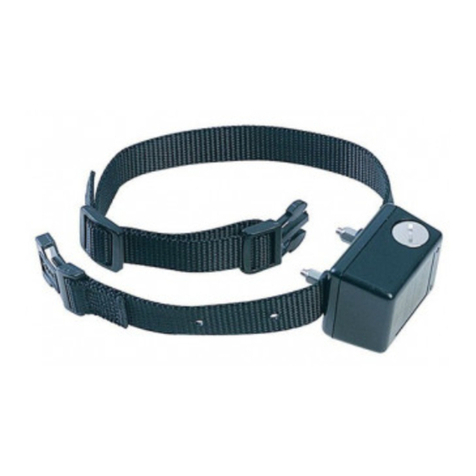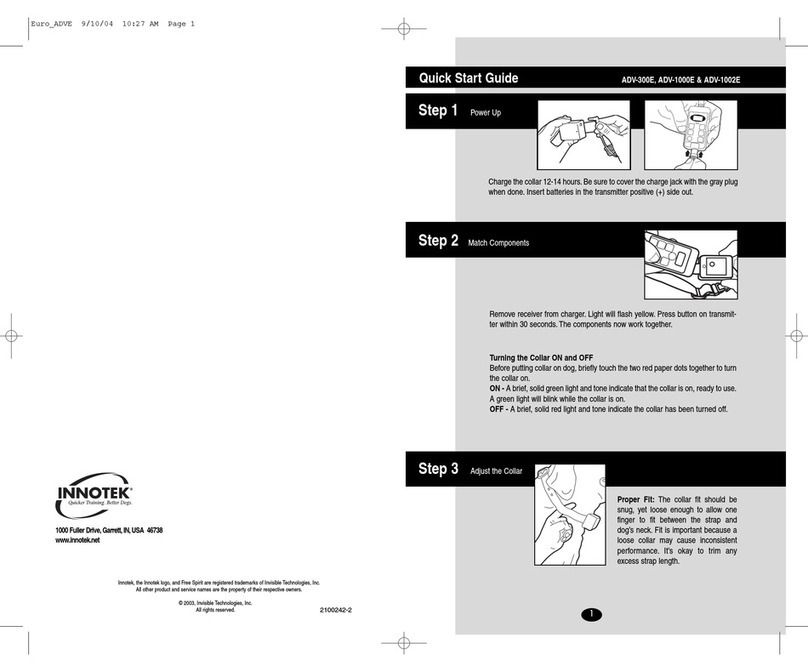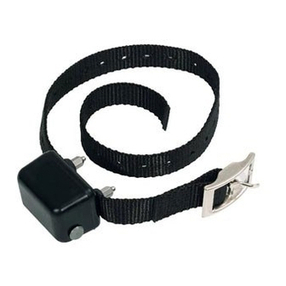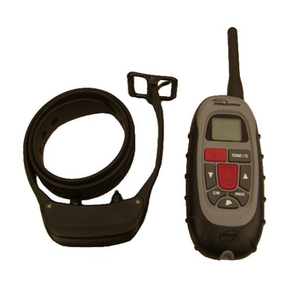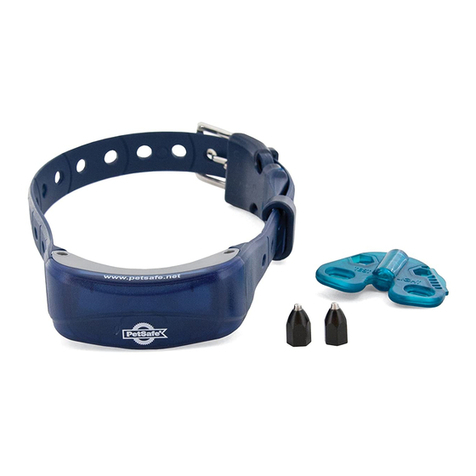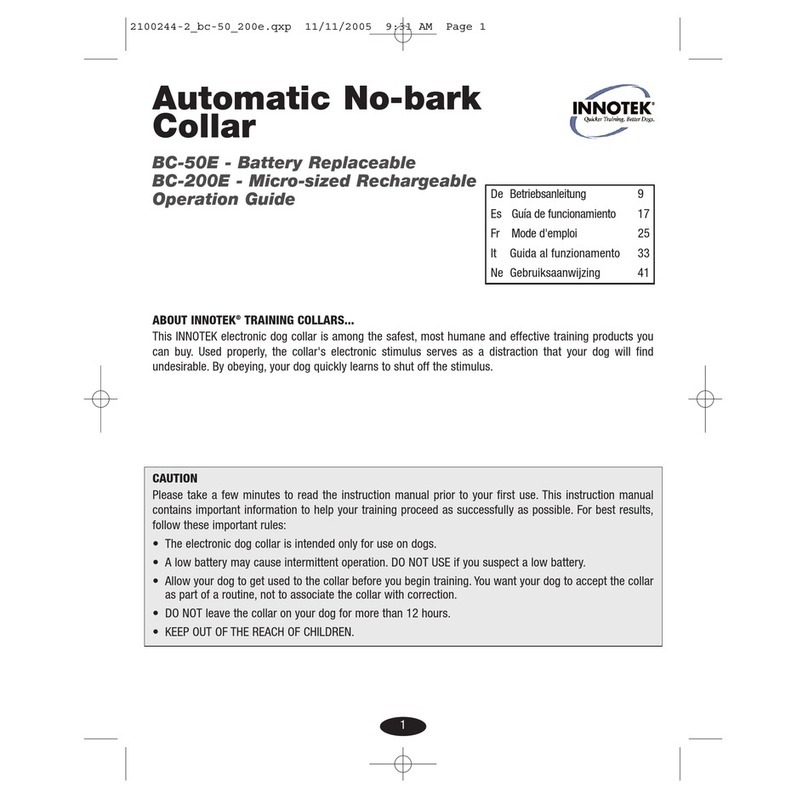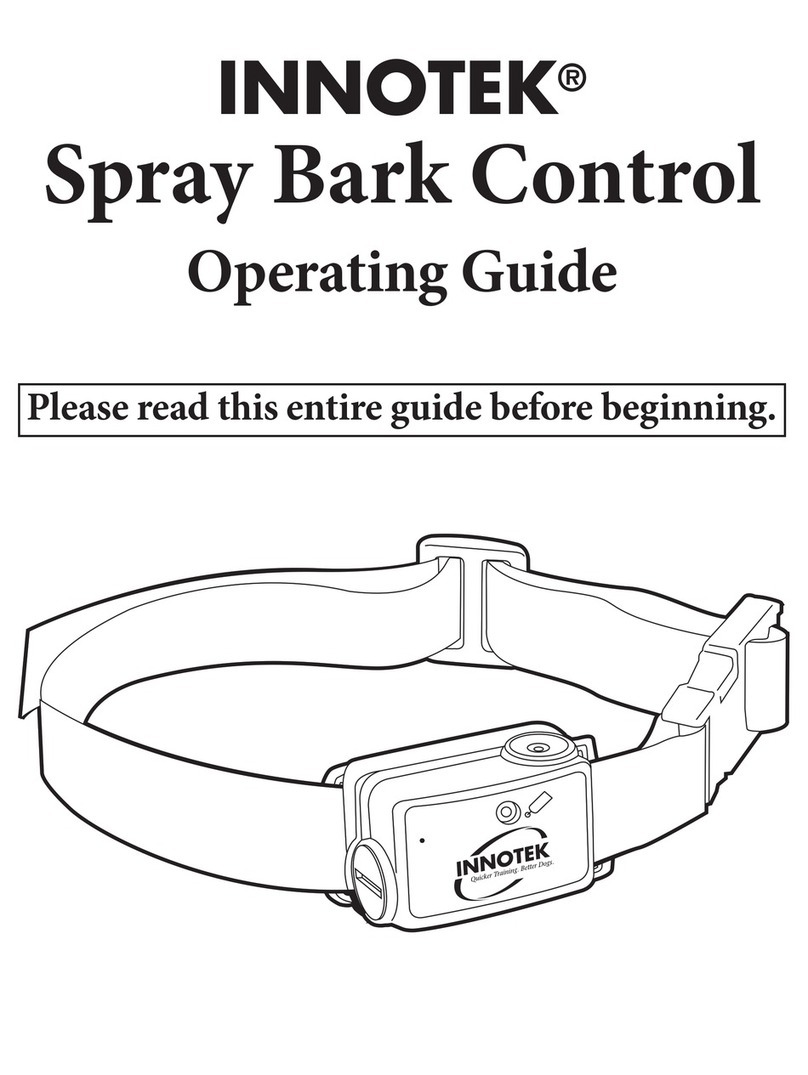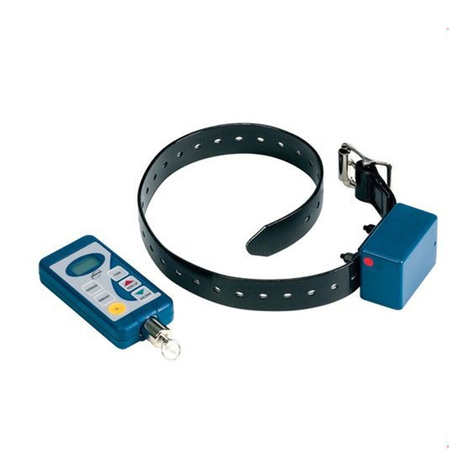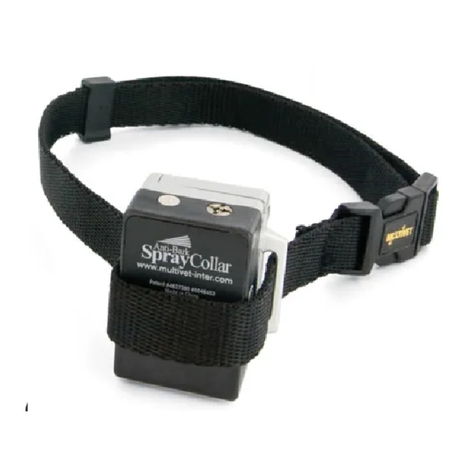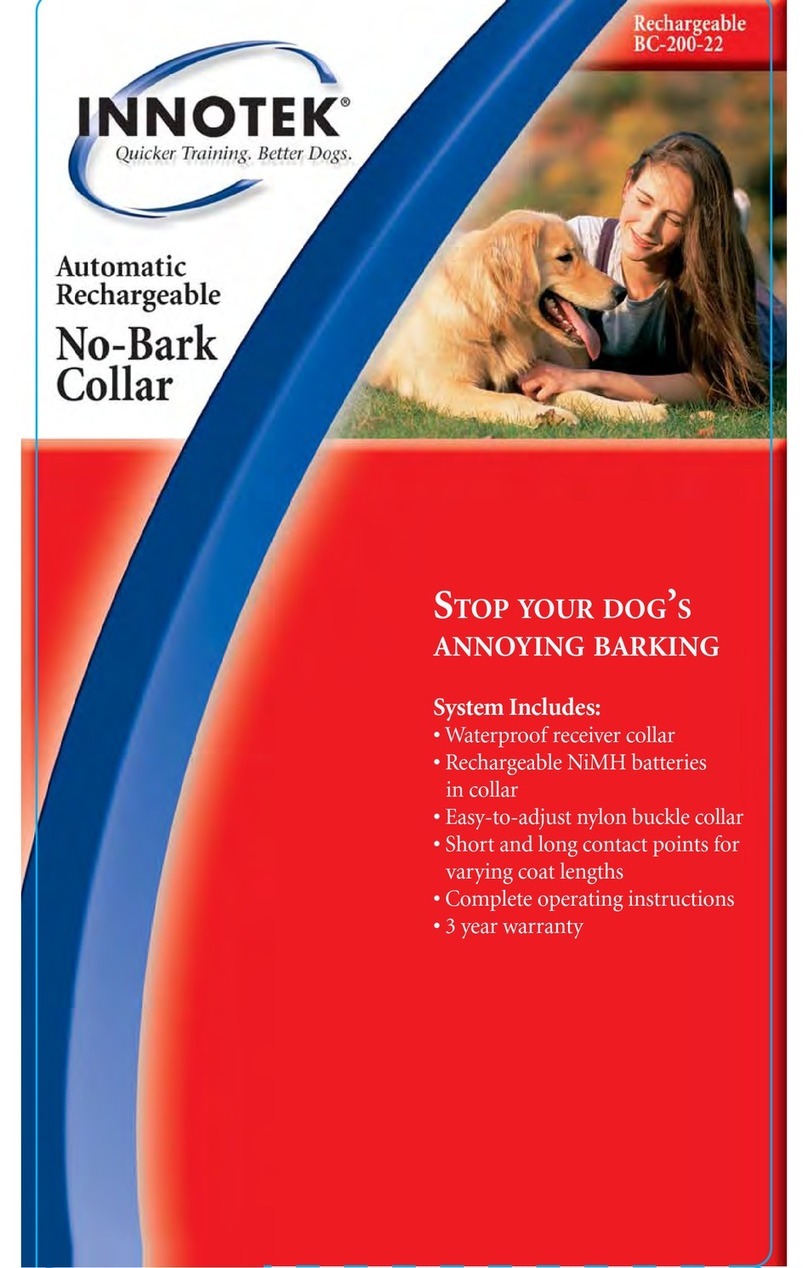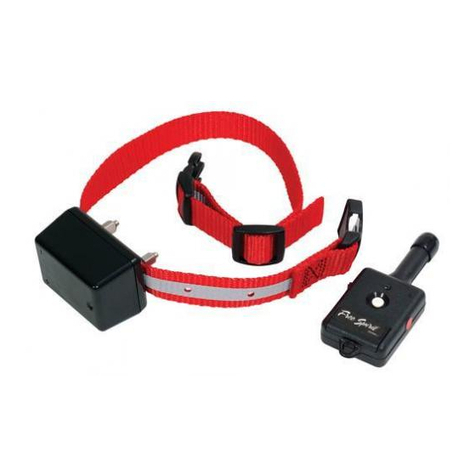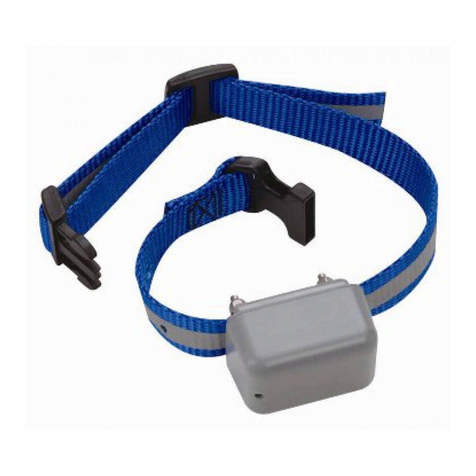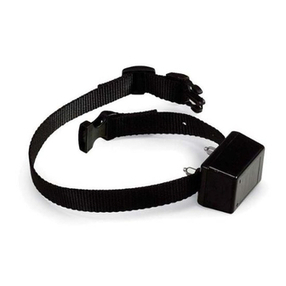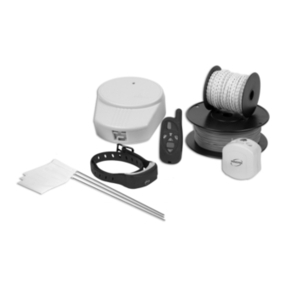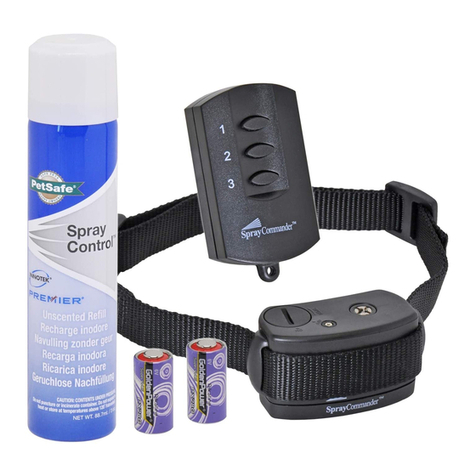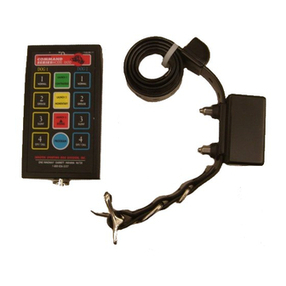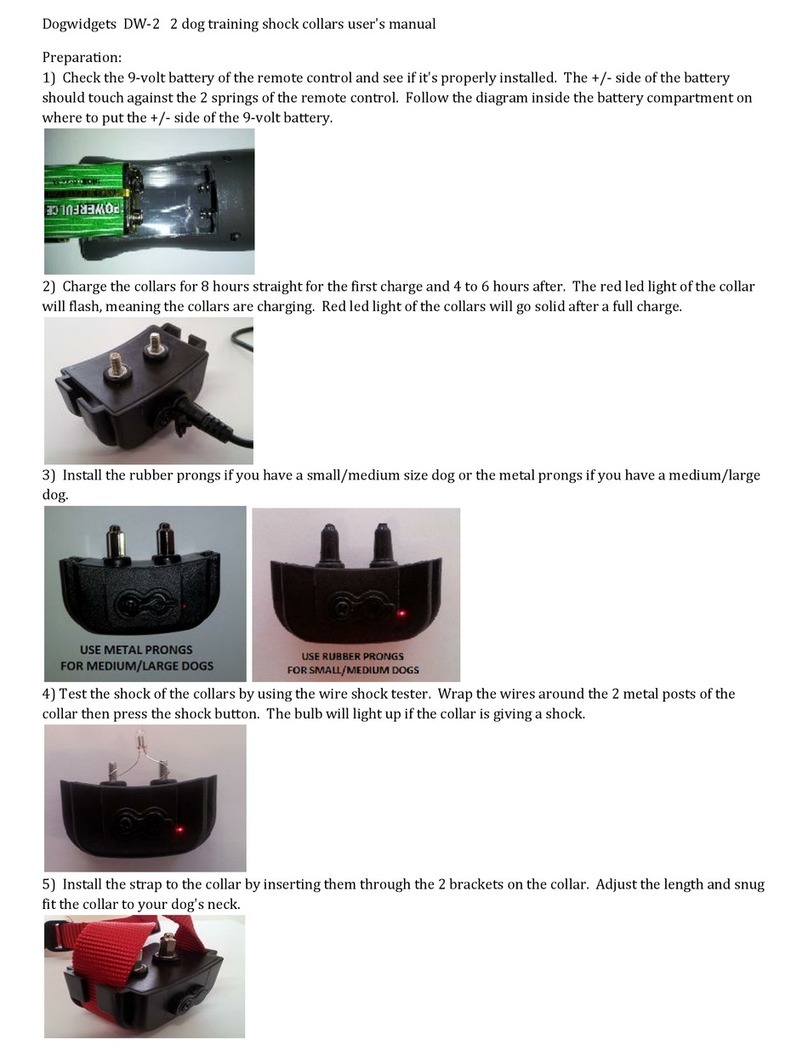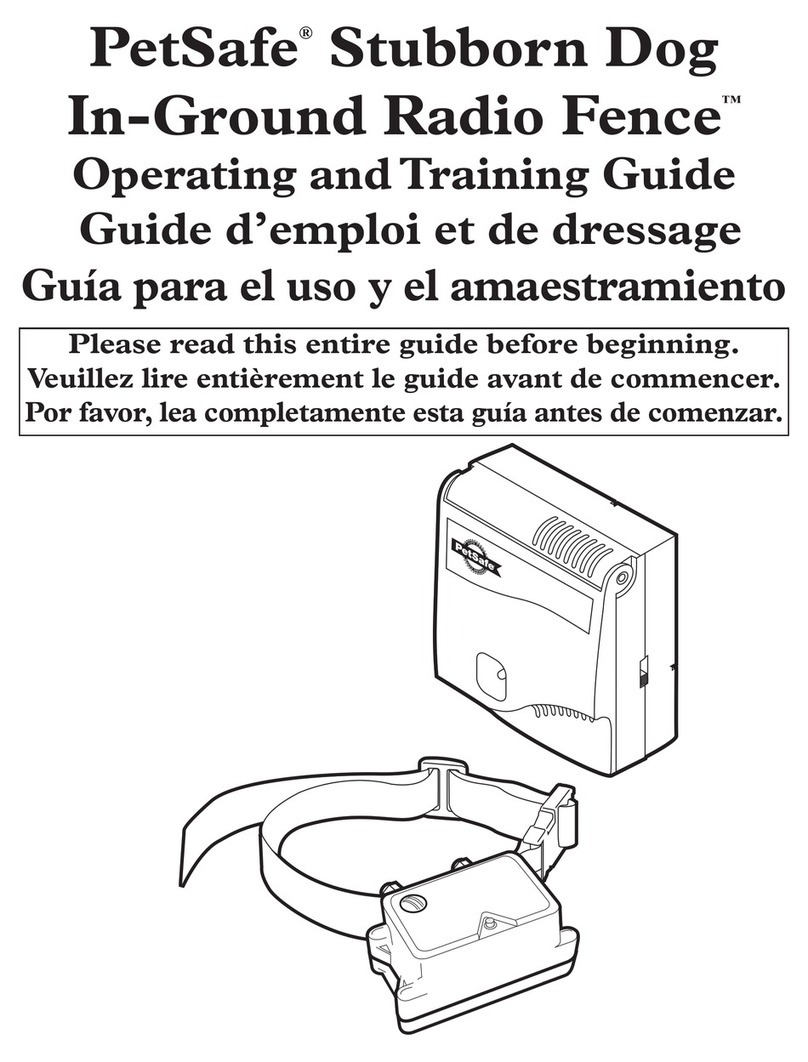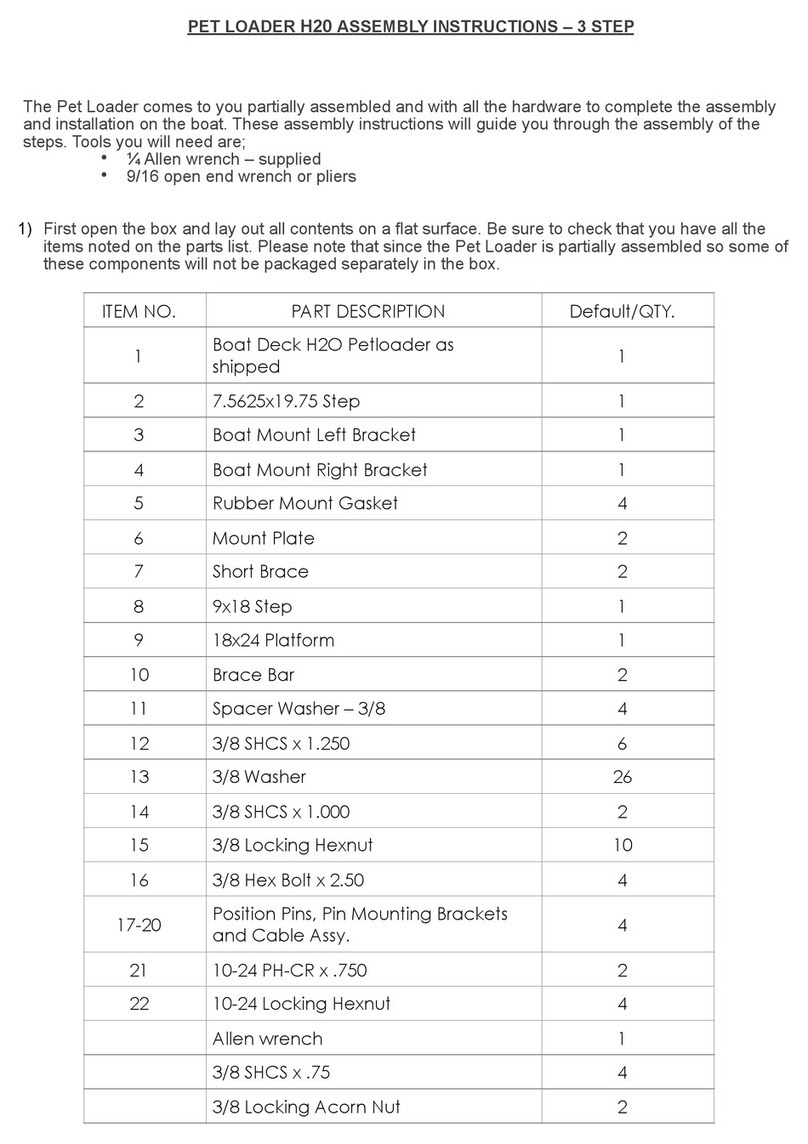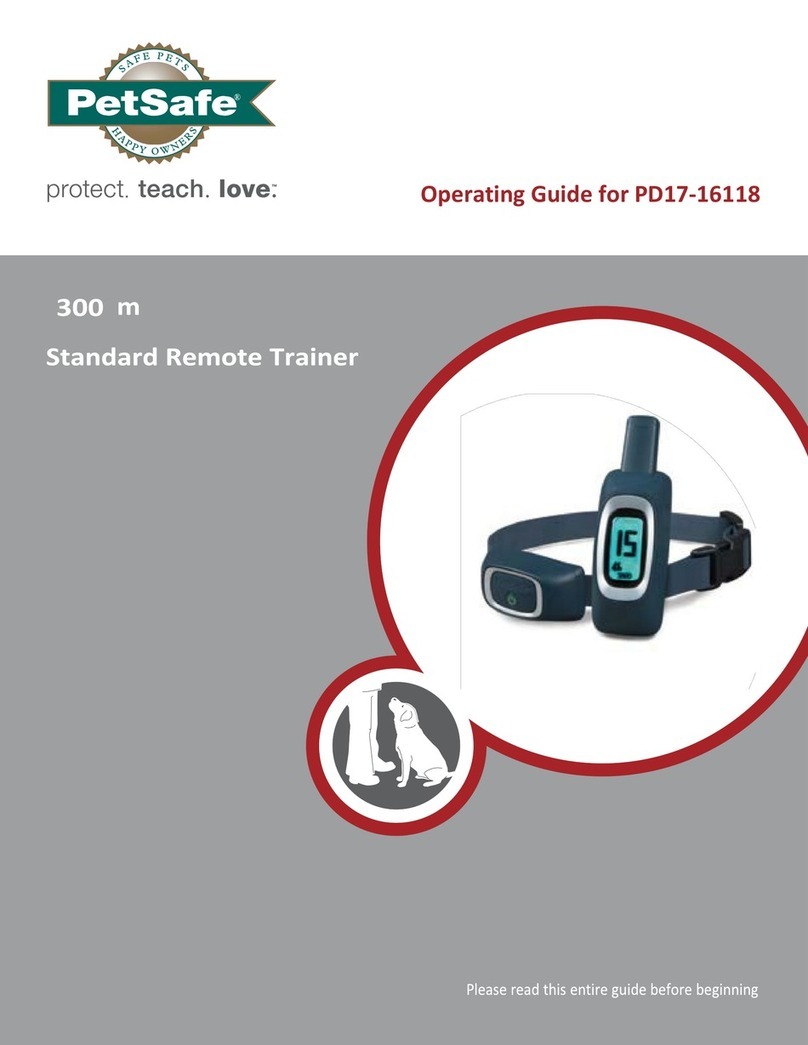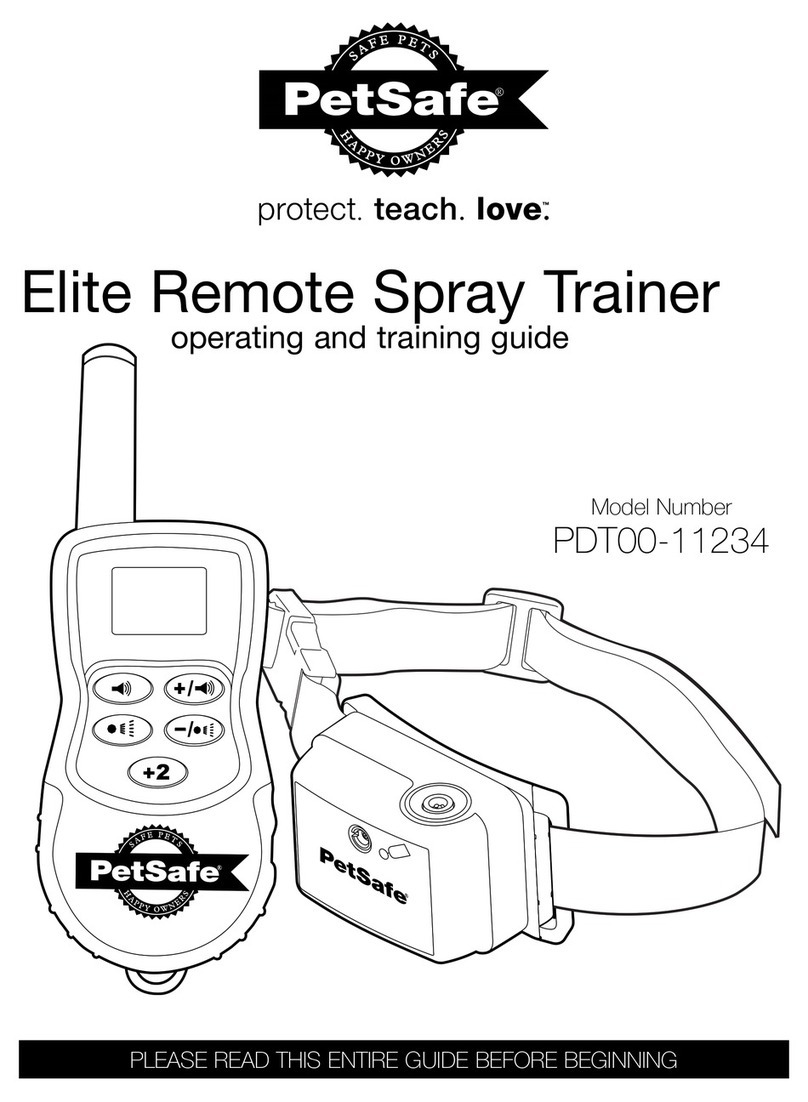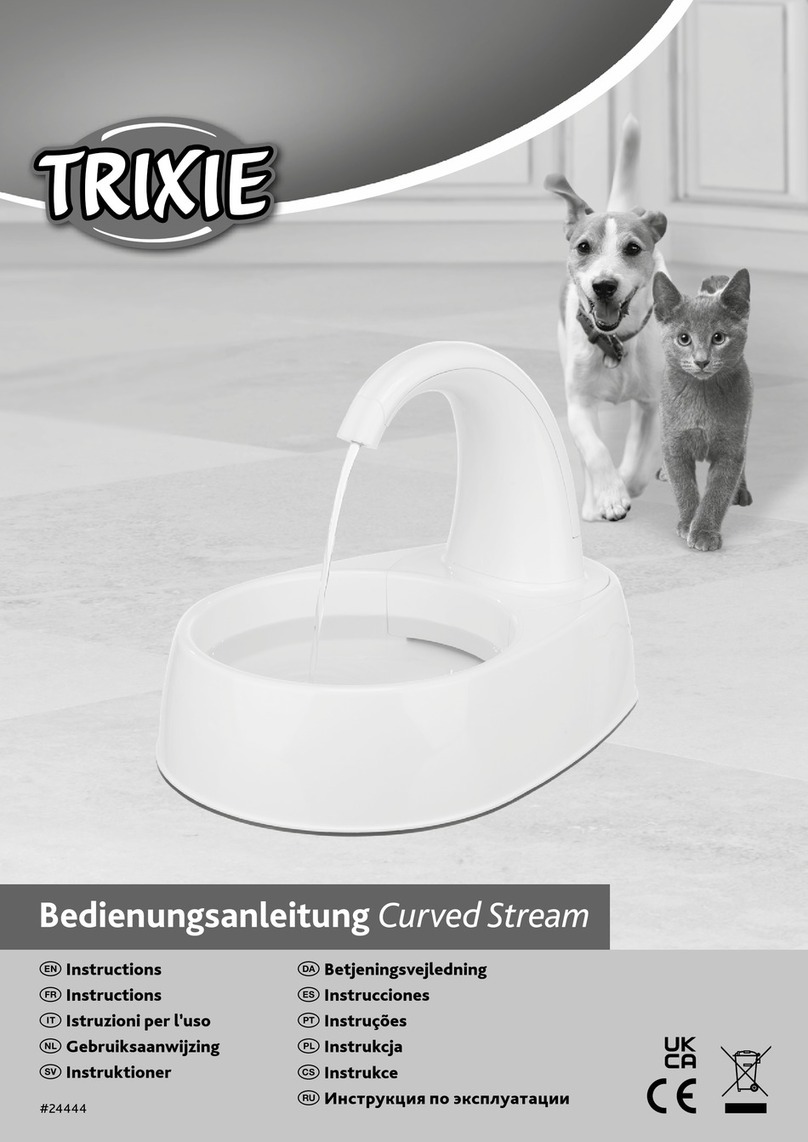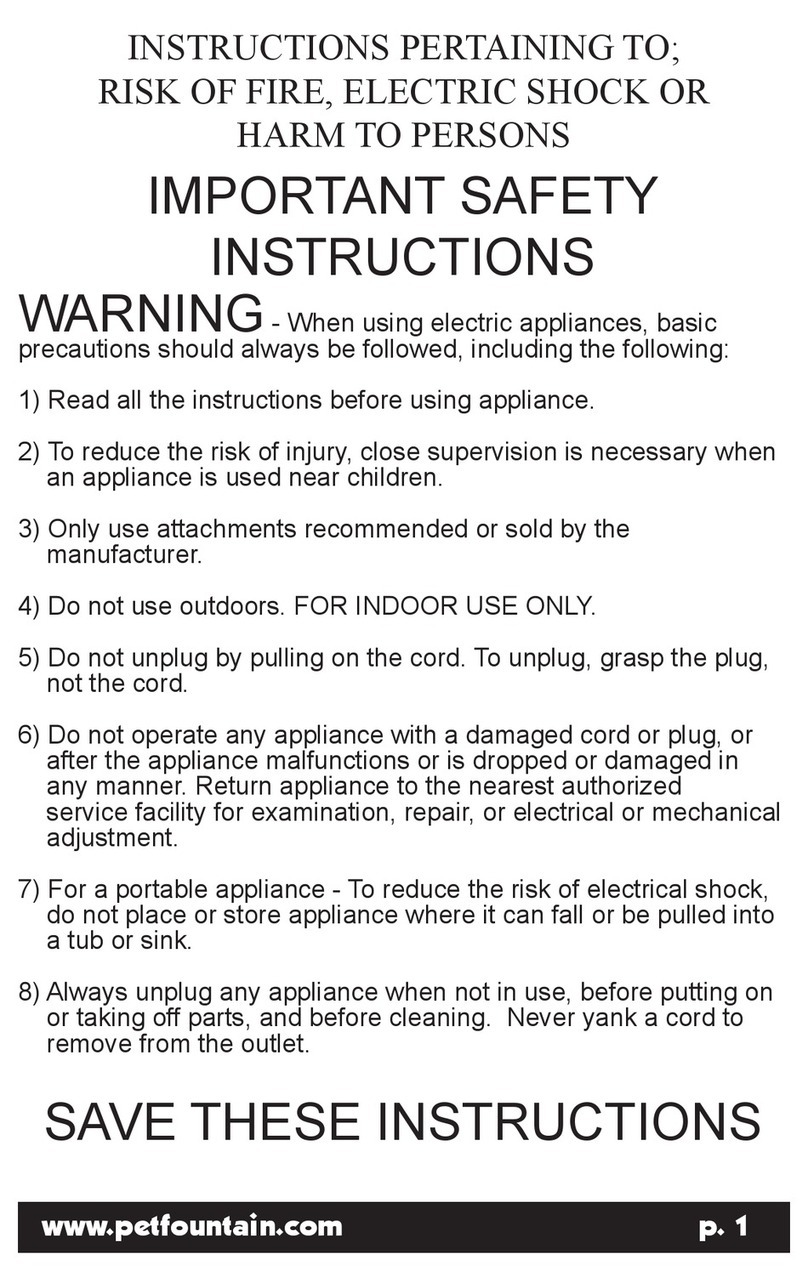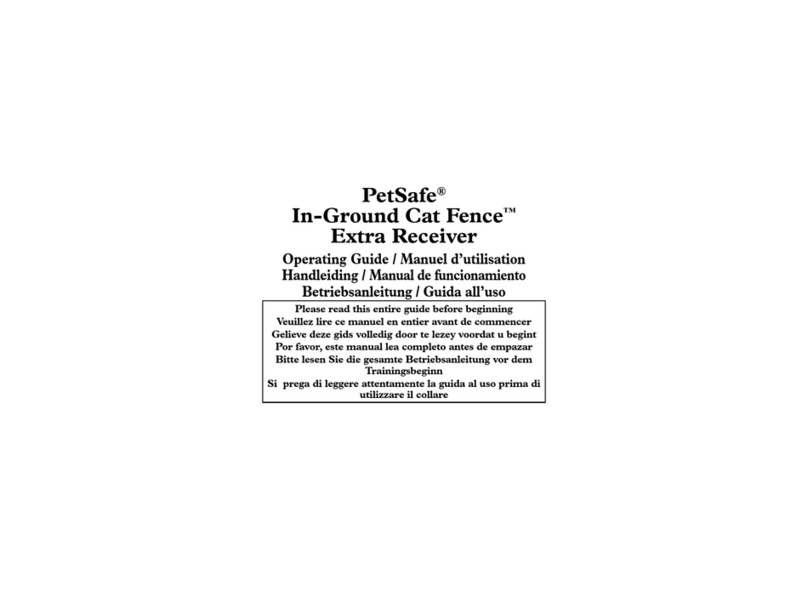1. Select a Location
Select an indoor, dry location to hang the wall-mount trans-
mitter.You will need a standard 110v grounded outlet within
5 feet for power.Most people find an inside exterior wall of
a garage or basement works well.You will need easy
access to run the containment wire outside.
2. Install the Mounting Plate
The mounting plate is attached to the back of the transmit-
ter.Remove by lightly depressing the dot on the top tab
and sliding the transmitter housing down the plate.
Use the mounting plate as your template and mark holes
with pencil.Fasten plate with supplied screws.
3. Install Battery Backup Batteries
(Optional, but recommended)
In case your power goes out, your system can run for up to
40 hours on 8 AA batteries (not included). Install batteries
and flip BATTERY BACKUP MONITOR switch to the ON
position.If you choose not to use the battery backup sys-
tem, set the BATTERY BACKUP MONITOR switch to OFF.
4. Provide for wire access to outside
You will need to get the wire from the transmitter to outside
where the containment loop will run.This can be done
through a window or you can drill a 1/4”hole at the base of
the wall to pass the wire through.After final installation and
testing is complete you can caulk the hole to prevent water
and insects from entering.
With the transmitter installed and the hole drilled for the
wire, you can position the boundary wire that will form your
fence.DO NOT bury the wire until you are sure that the
system is running properly.
1. Amount of wire
Your system includes 500 feet of boundary wire.The SD-
2200 includes an additional 100 feet of pre-twisted wire.
For larger areas, boundary kits with wire and splices, as
well as convenient pre-twisted wire are available from your
retailer or call 1-800-826-5527.Here are some examples of
wire coverage area:
2. Placing the wire
The wire must make a continuous loop from the transmitter
Step 3 Lay Out the Fence Wire
and back again.The signal is transmitted from one terminal
at the transmitter around the loop and back to the transmit-
ter again.Keep in the mind that you will want an 8’- 12’
containment signal field from you wire, so don’t run the
wire too close to the house and make passageways too
narrow for your dog to pass.
3.TwistedWire
Twisted wire cancels the radio signal coming from your
transmitter.This enables proper installation and your dog
can cross over the wire in the safe part of the yard.Where
there is single wire, the fence is active and your dog will be
unable to pass.Your kit may have come with FasTrak pre-
twisted wire or you can purchase it as a separate kit by
calling 1-800-826-5527.You can twist your own wire by cut-
ting two equal lengths of wire supplied and twisting them
together.Anchor one end of the wires to something secure
and insert the other end in a drill.Pull wire taught.The drill
enables you to twist the wire quickly.You will need at least
12 twists per foot to effectively cancel the radio signal.
4. Rounding Corners
Use gradual turns at the corners with a minimum of 2.5
foot radius.This will produce a more consistent contain-
ment field.
IMPORTANTTIPS!
• DO NOT run wire within 10 feet or parallel to cableTV,
phone and electrical lines.The signals can couple together
causing collar activation in the house and safe parts of the
yard.
• The wire must form one continuous loop from the transmitter.
• Use twisted wire to run between the transmitter and inte-
rior loops around pools and gardens to allow your dog to
safely pass around these areas (as illustrated in the cus-
tom loop pictures).
1. Splicing to the boundary wire
Pull the twisted wire to the perimeter location of the two
ends of your boundary wire loop.Splice the ends of the
twisted wire to the ends of the boundary wire with the sup-
plied waterproof splices as shown.Use only waterproof
splices supplied with this system.Additional splices are
available by calling 1-800-826-5527.Use of wire nuts
alone, electrical tape or solder will not provide a waterproof
and secure connection for your system to function properly.
To use the gel-filled capsule splice, strip 5/8’of insulation
from the wire ends.Insert ends of wire into nut and twist to
secure.Insert the wire nut as deeply as possible into the
waterproof gel and snap the lid shut.Tie a knot in the wires
as shown in Quick Step #4 to avoid having the wires pulled
free during installation.
2. Bring outside wire to transmitter
From the outside, push the twisted pair of wires through
Acres Linear Feet Needed
1 850
2 1200
3 1500
4 1700
5 1900
the hole in the wall.Strip about 1/2” of insulation from the
two ends.Insert ends into loop wire terminals marked on
the transmitter.
3. Plug transmitter in
Use supplied adapter and plug transmitter in.Move power
switch to the ON position.
The green light should illuminate on your transmitter indi-
cating a properly installed boundary loop. If the light does
not come on, refer to theTraining and Troubleshooting
Guide.
Final Connection - SD-2200 only
1.Plug Lightning Protection Module into the 110v outlet.
2.Connect the twisted wire ends to the loop terminals on
the Lightning Module.
3.Use two short pieces of twisted wire to connect from the
terminals marked “transmitter”on the Lightning Module to
the “Loop”terminals on the wall-mount transmitter.
4.Plug the transmitter adapter directly into the AC socket
of Lightning Protector (SD-2200 only).
For the collar to properly charge, the transmitter must be
plugged in, turned ON and have the fence wire attached.
For this reason you will not charge your collar until you
have the layout of the boundary wire where you want it.
To Charge:
1.Place collar receiver on top of wall-mount transmitter in
the charging cradle with probes up.
2.The transmitter light will flash green when properly seat-
ed.
3.Wait 14 hours.(A high frequency noise during charging
is normal).
4.If charging multiple collars, wait at least 15 seconds
before placing the next collar in the cradle.
You should have your boundary wire laid out and properly
connected and the collar receiver should have charged for
14 hours.DO NOT test the system on your dog.
1. Field size switch
Set to small (SM) for installations using less than 1000’of
wire.For larger installations, move the switch to large (LG).
2. Adjust containment field
Move the FIELDWIDTH knob to the 9 o’clock position.
3.Test system
Select a section of straight boundary wire that is at least
50 feet long.Attach the supplied test light to the receiver
Step 4 Final Connections
Step 6 TestYour Fence
probes and hold the collar receiver at your dog’s neck
height.Slowly walk the collar toward the boundary wire.
Listen for the warning tone and watch for the test light to
light.The wider you can make the containment field, the
less chance your dog can run through.Adjust the FIELD
WIDTH as necessary and test again.
Test in a number of different areas until you are satisfied
there are no wire breaks and the system is functioning
properly.
Next walk all around the“safe”part of the yard to ensure
there are no stray signals, particularly near the twisted wire
coming from the transmitter.Test collar in and around the
inside of the house as well.As mentioned prior, signals
from CableTV, electrical or telephone lines may transfer
stray signals inside and outside the house that can activate
the dog’s collar accidentally. If you do encounter this phe-
nomenon, your boundary wire is probably too close to
these outside lines and will need to be moved or modified.
Containment collars should not be worn inside house.
You may need the following tools for efficient installation:
Straight edge spade or a gas powered edger.If you plan
on running the wire across a driveway you may also need
a caulk gun, silicone caulking and a circular saw with a
masonry blade.
1. Ensure system is turned off
Turn off the transmitter and unplug the adapter from the
AC outlet.
2. Bury the wire
Dig a trench 1”-3” deep with a flat edge spade or gas-pow-
ered edger.A 30 - 45 degree angle cut will be the easiest
to close and keep the wire in the trench.Make sure there is
a little slack in the wire as you bury it to compensate for
expansion and contraction due to temperature changes.
When crossing an asphalt driveway, make a 1/4” deep cut
across the driveway using the circular saw and masonry
blade.Place the wire in crack and seal with asphalt
sealant.In concrete there is usually an expansion joint that
can be cleaned out and used for the same purpose and
covered with clear silicone caulk.
The wire can be placed underwater in creeks and streams
by running the wire through PVC pipe or a length of garden
hose to prevent the wire from being damaged.
3. Place training flags
Repeat the TEST SYSTEM steps outlined in the Step 6.As
soon as you hear the warning tone, place one flag.Repeat
the process every 10’ interval around the containment
area.The flags will be your dog’s visual clue to the bound-
ary during training and will be removed during the training
process.You are now ready to begin training your dog.
Step 7 Bury Fence Wire
6. 7.
Step 5 Charge Collar
Step 2 Install the Wall-mount transmitter




